News Around NIDDK
The end of an ARRA: NIDDK stimulus funding reaps results
By Bill Polglase and Amy F. Reiter
In 2009, the American Recovery and Reinvestment Act (ARRA) funded $8.2 billion in NIH extramural research to stimulate the U.S. economy through the support and advancement of science. Now, four years later, much of this research has borne results that hold promise for developing new treatments for a range of serious diseases.
Among many examples are results from the Longitudinal Assessment of Bariatric Surgery (LABS) in adults and Teen-LABS in adolescents, observational studies of the risks and benefits of bariatric surgery.
ARRA funding enhanced the ongoing studies, making possible home visits to LABS participants unable to return to the original research center, enabling valuable follow-up. The funding also enabled the researchers to improve the evaluation of sleep apnea, a breathing disorder commonly tied to obesity, with polysomnogram technology to analyze a subset of patients in both studies. ARRA funding has also enabled further analyses of biological samples from participants in both studies.
“ARRA funding for LABS did just what it was meant to do,” said NIDDK Program Director Dr. Mary Horlick, who helps oversee LABS and Teen-LABS. “The funding enhanced both the pace and depth of research through home visits and analyses of sleep studies and biological samples that would not have been otherwise possible.”
In another ARRA success story, researchers at the University of Colorado School of Medicine identified insulin resistance as a risk factor for cardiovascular disease (CVD) in adolescents with type 1 diabetes. They found that adolescents with type 1 diabetes who were the most insulin sensitive had similar CVD risk factors as youth who had no form of diabetes. However, as insulin sensitivity decreased, CVD risk factors worsened. These results suggest that monitoring and controlling insulin sensitivity through lifestyle approaches or medications may be a way to reduce CVD risk in people with type 1 diabetes.
Also supported by ARRA funding, Vanderbilt University scientists discovered a chemical bond essential for animal life and which hastened the “dawn of the animal kingdom.” In a discovery that could lead to new therapies for cancer and other diseases, the study demonstrates that the sulfilimine bond is part of a primordial innovation dating back more than 500 million years to the ancestor of jellyfish.
“This discovery marks a culmination of Vanderbilt’s efforts to engage and elevate science, technology, engineering and math achievement in rural K-12 students, as a strategy to reach the ‘forgotten student’ and to promote public understanding of science,” said Dr. Billy G. Hudson, Elliot V. Newman Professor of Medicine, Pathology and Biochemistry and director of the Center for Matrix Biology at Vanderbilt University Medical Center.
This sulfur-to-nitrogen bond stabilizes the collagen IV scaffold and is essential for more-advanced tissue formation. The advance is just one of many under Vanderbilt’s Aspirnaut program, which provides a summer research experience for students from underrepresented groups. (Editor’s note: For more about Aspirnaut, see the Fall 2012 NIDDK Director’s Update.)
Students discuss their experience in the Aspirnaut program.
Credit: Vanderbilt University
NIDDK’s Phoenix branch makes mentoring a mission
By Krysten Carrera
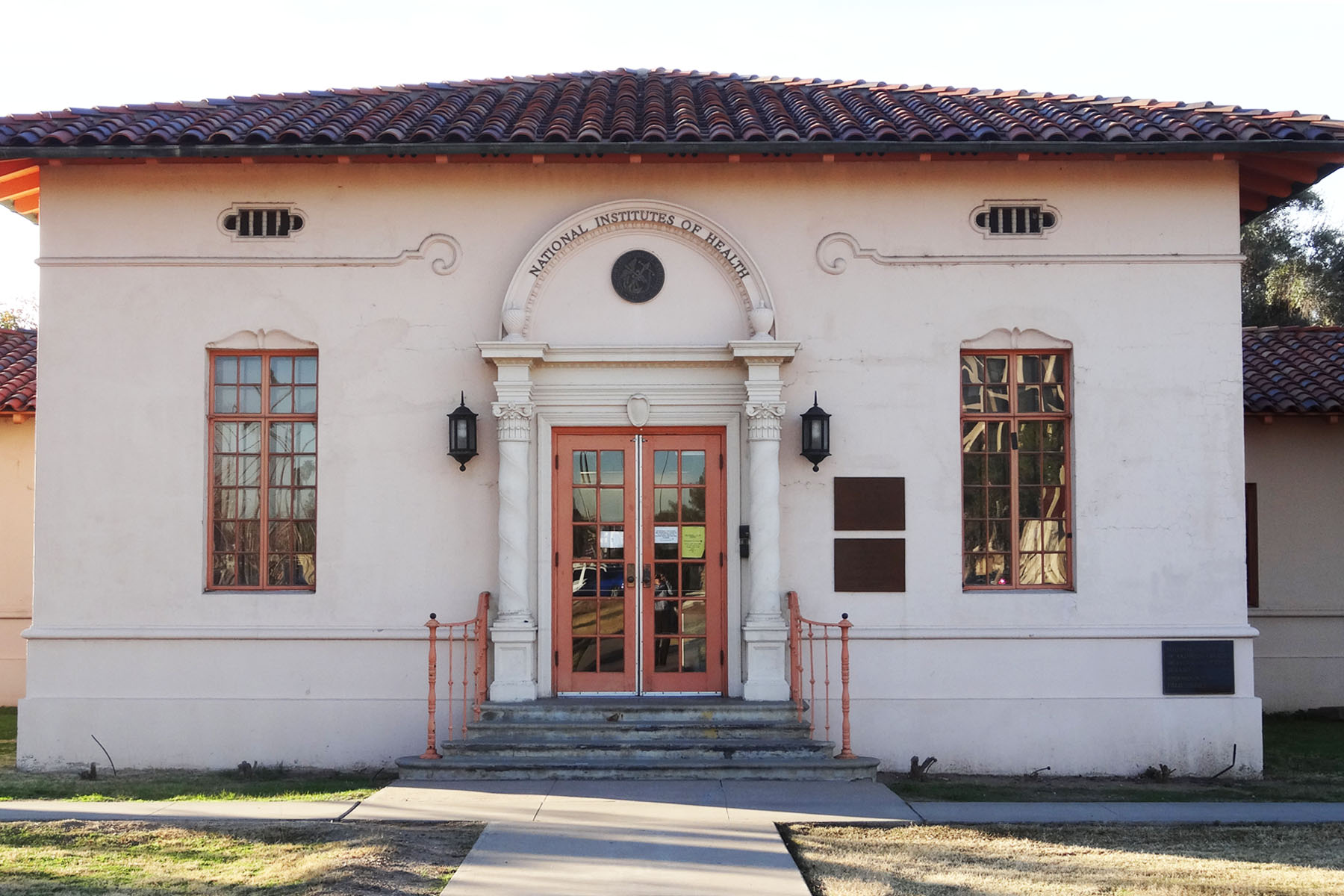
A successful training experience calls for a few key ingredients: a welcoming environment, supportive senior staff, and work that is both meaningful and rigorous. Like many labs and branches at NIDDK, the intramural Phoenix Epidemiology and Clinical Research Branch (PECRB) meets those requirements and more. Since the branch’s inception in 1965, trainees across the spectrum of experience have benefited from a climate that nurtures professional development – while at the same time giving trainees opportunities to make lasting contributions to research.
PECRB is NIDDK’s only intramural branch not located on the main NIH campus in Bethesda, Maryland. Researchers in the branch use several approaches to determine the causes of obesity and type 2 diabetes for the purposes of improved prevention and treatment, especially in Native Americans, an at-risk group. Though mentees come from all over the world to train at PECRB, a number are from Arizona, including the local Phoenix community.
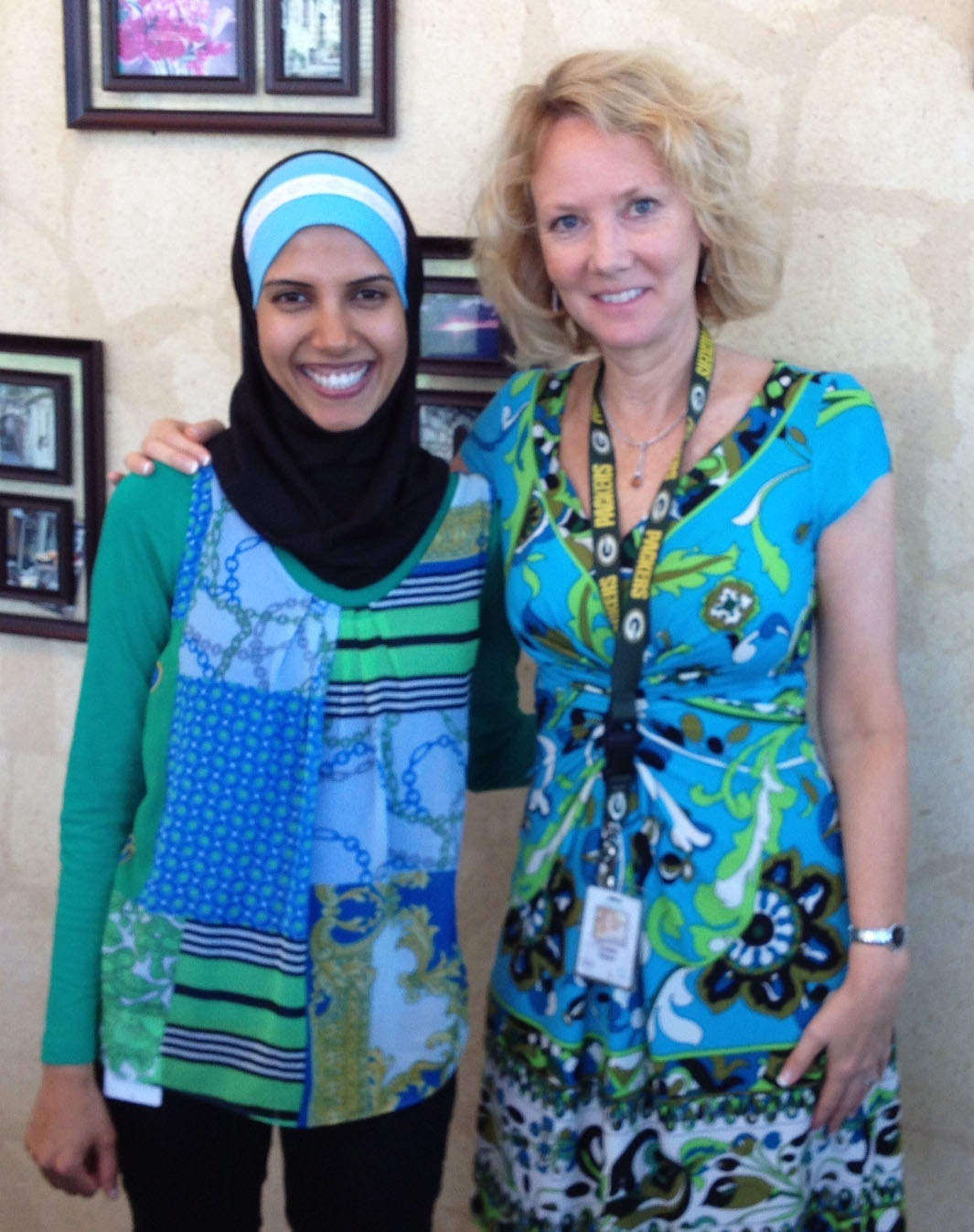
“Over the years, my colleagues and I have mentored hundreds of young people, from undergraduates representing colleges nationwide who want an internship to build their academic resume, to post-docs hailing from all parts of the globe who want training at a high-profile American institute, to local high school students still trying to decide upon a career path,” said Dr. Leslie Baier, a senior investigator and section chief at PECRB. “Together we identify their area of interest and ability and come up with assignments that will help them grow as scientists.”
Many of Baier’s mentees have gone on to successful careers in academia, medicine and genomic industry. Former mentee Maryam Abdussamad received training as a technical IRTA from 2009 to 2012. She recently graduated with a master of science from Georgetown University and plans to pursue an M.D.-Ph.D. degree.
A Phoenix native, PECRB is her “second home,” Abdussamad said. “My experience at PECRB helped me decide to pursue biochemistry and molecular biology research.”
Dr. Jeremy Pomeroy is a postdoctoral fellow who received guidance from multiple senior staff when he started at PECRB in 2006. Since then he has assumed a leading role in the NIDDK-funded LIFE-Moms study and now mentors multiple trainees of his own every summer.
“In many ways, PECRB’s environment is conducive to mentoring,” said Pomeroy. “Anyone can attend regular section meetings, and even the more junior people are encouraged to take the lead on discussions. That, along with senior investigators’ open-door policy, allows everyone’s ideas to be heard. Mentees and investigators alike benefit from this kind of collaborative atmosphere.”
PECRB Chief Dr. Clifton Bogardus concurs. “The research we conduct as a team greatly advances our mission,” he said. “Mentoring the next generation of scientists is something that is important to the branch here in Phoenix as well as across NIDDK.”
NIDDK takes part in country’s largest STEM festival
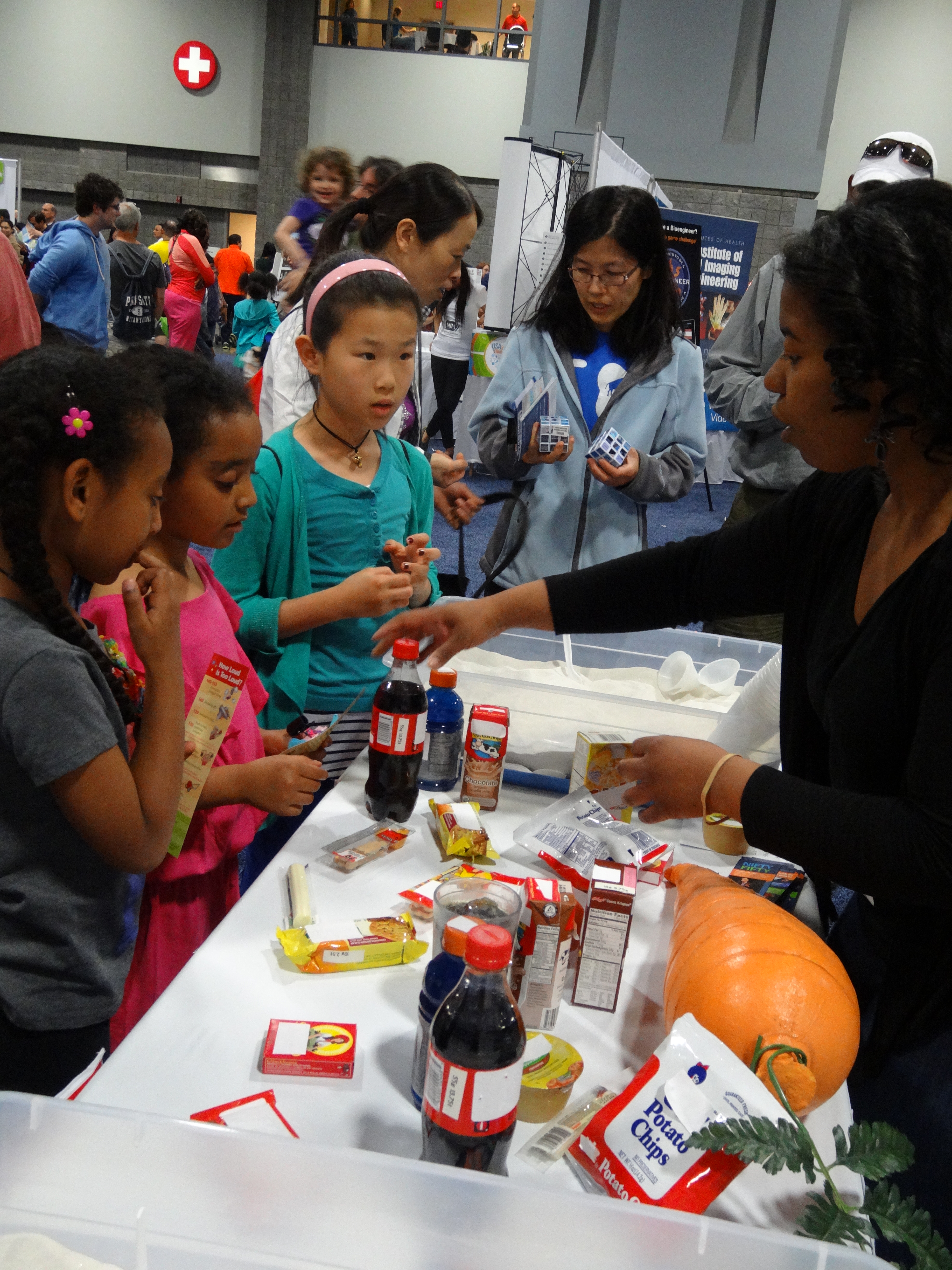
NIDDK's Dacia Beard helps children "Be a Sugar Detective" at the USA Science and Engineering Festival, held in Washington, D.C., April 24-27. As part of NIDDK's activity, hundreds of children tested their knowledge of how much sugar is in foods and drinks, often coming away saying they will make healthier, lower-sugar choices.
dkNET launches to provide better data access
By Amy F. Reiter
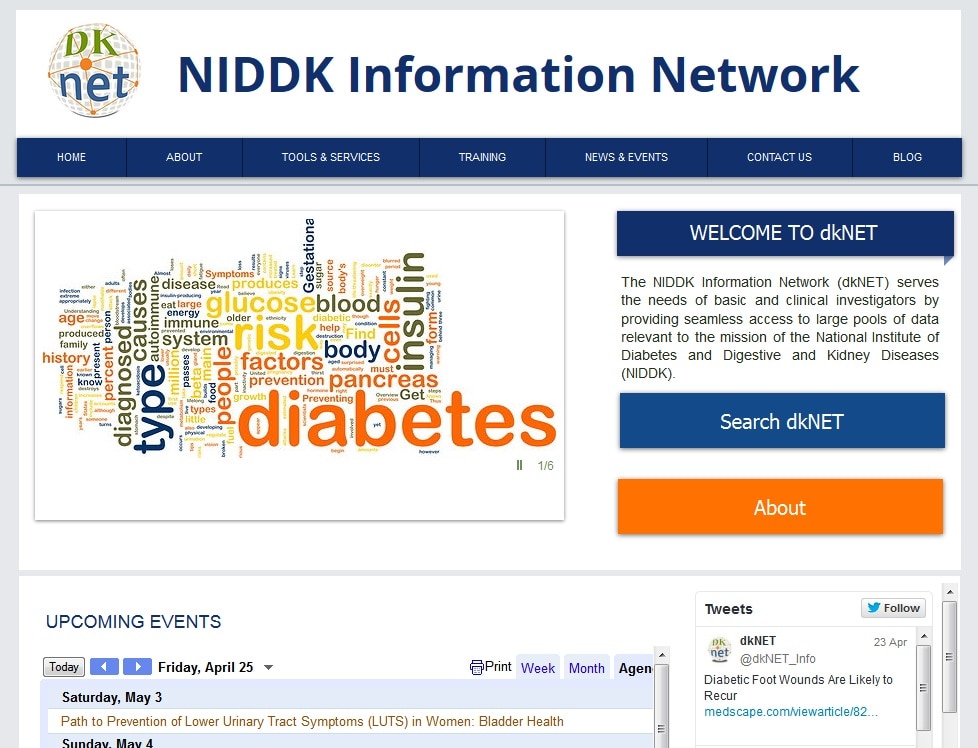
When NIH funds a study, the data become available for future research. But studies generate a lot of data, and sifting through the Internet to find just what’s needed can feel like a losing game of hide and seek.
That’s why NIDDK, working with researchers at the University of California – San Diego and elsewhere, created dkNET, also called the NIDDK Information Network. Launched in April, the online data resource is meant to serve as an index to NIDDK-supported online resources, including datasets from basic science consortia and several human genetics databases devoted to the mission of NIDDK—about 1,900 total resources thus far. DkNET also takes users to related sources of data through links to the broader universe of online digital networks.
Within NIDDK, program director Dr. Ronald Margolis is leading the effort. “Scientists generate enormous amounts of data, but often there is no coherent means for finding it,” he said. “DkNET uses advanced informatics tools to establish an online ‘data-mart’ for NIDDK investigator-generated data.”
DkNET architect and UCSD neuroscientist Dr. Maryann Martone came to the project from a parallel track. Designing a neuroscience portal with a similar mission, she found many data lists but, as she said, “no good way of tracking and making collectively searchable all of the existing digital resources.”
To improve searchability, she and colleagues created “SciCrunch,” a web structure that serves as a common base from which researchers can cost-effectively build and share data repositories. Originally applied to the neuroscience information framework, SciCrunch is now serving as the backbone for dkNET.
Margolis thinks such sharing of data and tools will enrich the research landscape in serendipitous ways. “By enabling discovery of and access to NIDDK data,” he said, “researchers will be able to compare their data to already existing data and to validate their research, add to the existing store of knowledge, generate new ideas and avoid repetition.”
The site already boasts significant resources, from the GenitoUrinary Development Molecular Anatomy Project to the Beta Cell Biology Consortium, and should continue to expand. “In the future,” Martone said, “we will release analytic tools that look across all data for trends and knowledge gaps in ways we could never do before. Once you provide a new set of tools to allow researchers to look at issues in different ways, new types of discovery usually follow.”
Dr. Lawrence Agodoa delivers remarks at Native American heritage event
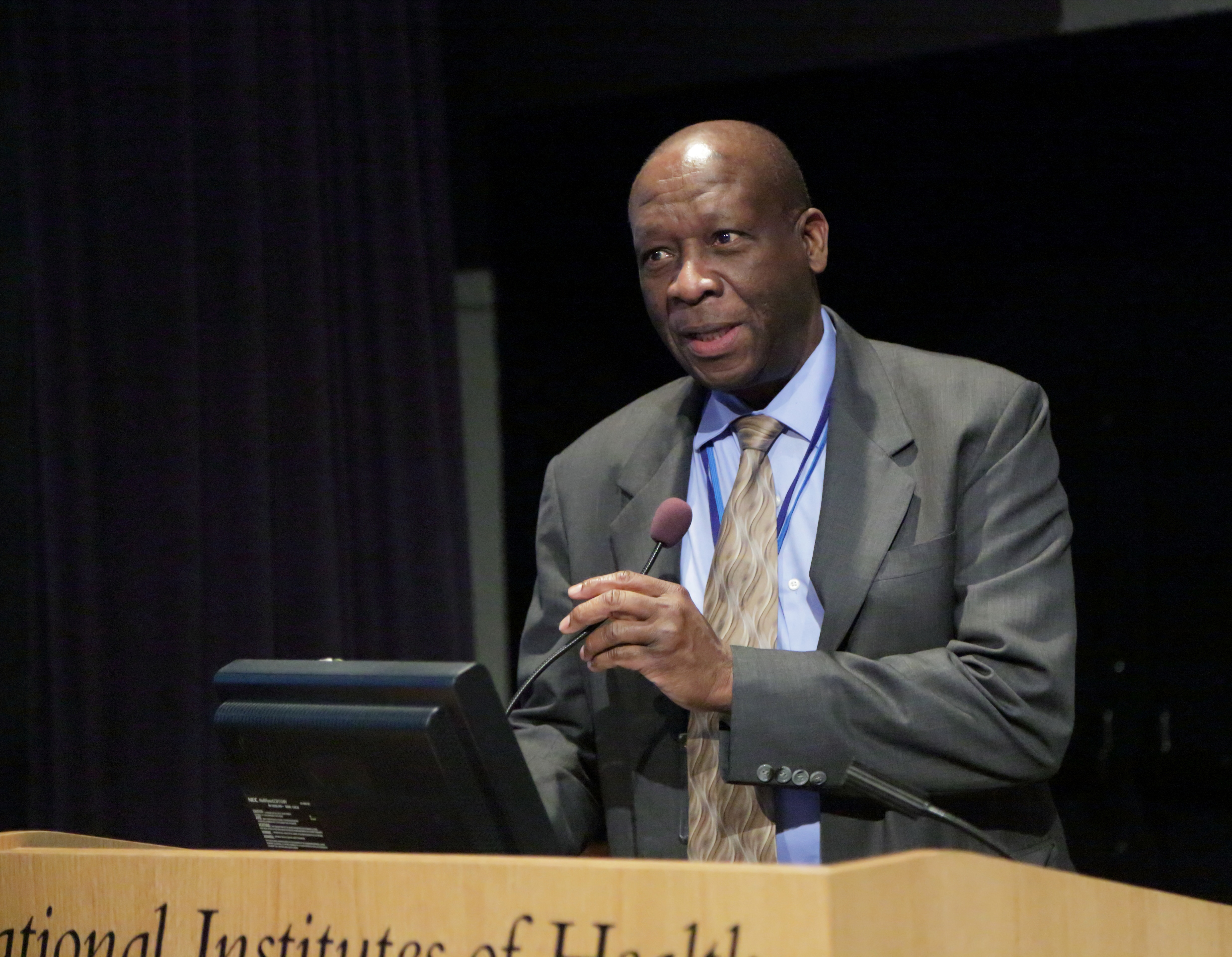
Dr. Lawrence Agodoa, director of NIDDK’s Office of Minority Health Research Coordination and a program director in the institute's Division of Kidney, Urologic, and Hematologic Diseases, spoke about NIDDK’s Diabetes Education in Tribal Schools (DETS) program at the National Native American Heritage 2014 Speaker Series on April 3. DETS is part of a national effort to decrease the incidence and improve the care of type 2 diabetes among American Indians and Alaska Natives. Agodoa said the program enables NIDDK to provide resources to support translation of science to have a positive long-term impact on the people the program serves.
Getting to know: Dr. Susan Z. Yanovski
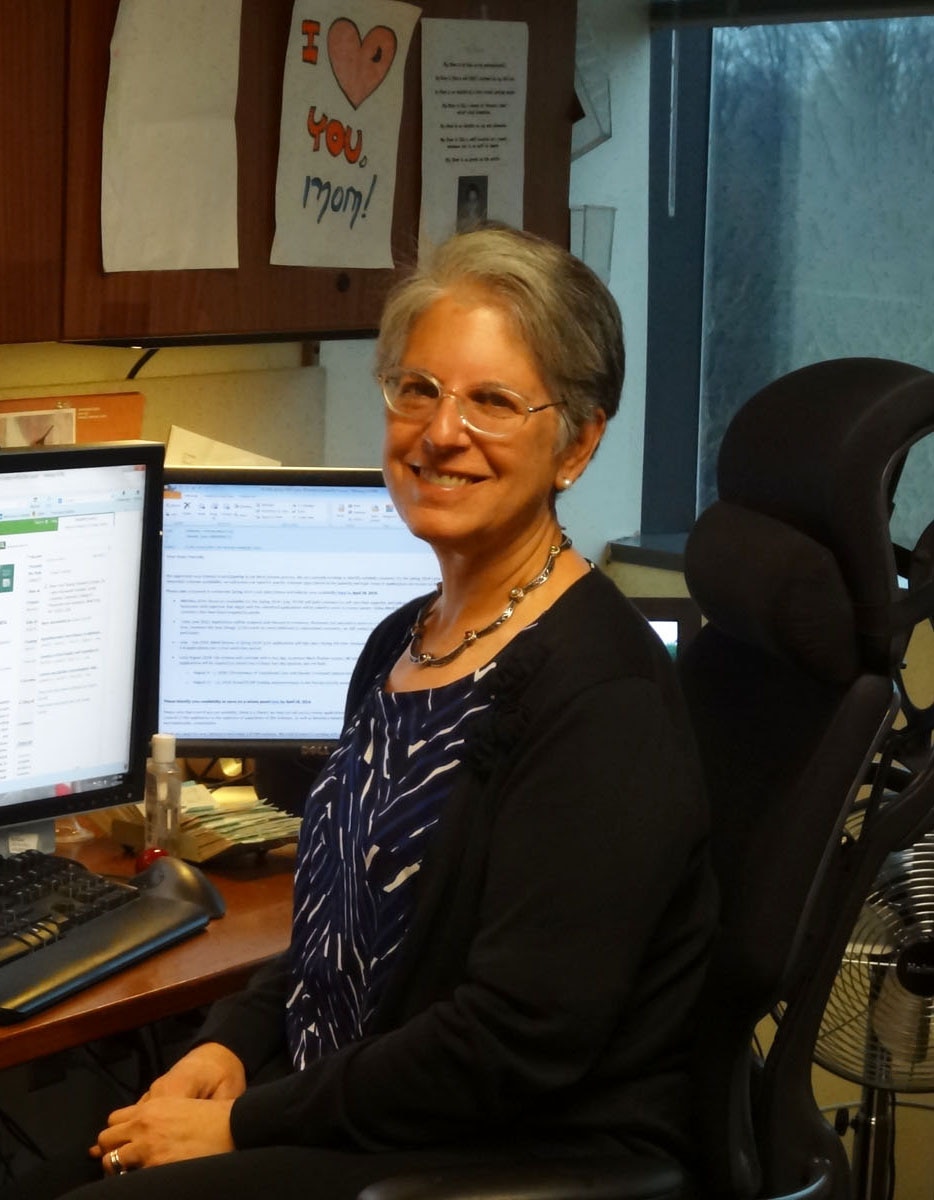
Dr. Susan Z. Yanovski, an M.D., is co-director of NIDDK’s Office of Obesity Research and a program director in NIDDK’s Division of Digestive Diseases and Nutrition. She’s also a clinical researcher in the intramural Section on Growth and Obesity at the NIH’s Eunice Kennedy Shriver National Institute of Child Health and Human Development. She recently spoke with Amy F. Reiter about her career and the changing landscape of obesity research.
What brought you to NIH initially?
I did a fellowship with the National Institute of Mental Health, which had an active research program in eating disorders. Being a fellow at NIH was like heaven for a young researcher! Just as I was starting, there was a national effort to develop diagnostic criteria for a new category of eating disorders called Binge Eating Disorder, in which individuals had binge eating episodes but, unlike people with bulimia nervosa, do not also engage in purging. Those with Binge Eating Disorder are often obese. I helped design and served as principal investigator on three intramural protocols studying biomedical and behavioral aspects of Binge Eating Disorder.
It seems like you wear many hats within NIDDK and NIH as a whole – what does an average day look like?
One of the things I love about my job is that no two days are alike! One day last week, I co-led a meeting of our trans-NIDDK Obesity Research Working Group, met with colleagues regarding development of new NIDDK and trans-NIH initiatives, advised an early career investigator on submitting his first NIH grant application, participated as NIH liaison to the external scientific panel advising the National Collaborative on Childhood Obesity Research, provided input on an intramural research protocol, and worked on a paper reporting results from one of our multisite clinical trials. My work is a wonderful combination of clinical research, administration and mentoring.
Your husband is also an obesity researcher. How does that continuity between home and work affect the research that you supervise and conduct?
My husband, Dr. Jack Yanovski, and I are extremely fortunate to be not only spouses and best friends, but also research collaborators. I conduct research with Jack in the Section on Growth and Obesity in NICHD on studies of binge and loss-of-control eating, primarily as they affect children and adolescents. Jack and I also have written many papers together. I admit we do indulge in some “shop talk” at the dinner table, such as sharing a new and interesting paper we’ve read or talks we’ve heard. In fact, we joke that our children could say “randomized double-blind placebo controlled trial” before they entered pre-school. The opportunity for me to be an active collaborator in ongoing clinical research enhances my ability to carry out my extramural responsibilities.
How has the field of obesity research changed since you first came to NIDDK in 1992?
When I first became a program director in NIDDK, there were only a couple of us across the institute who had obesity research as our primary focus. Over the years, NIDDK’s scientific commitment to and investment in obesity research expanded dramatically, particularly after the discovery of leptin in 1994 and subsequent explosion of knowledge about pathways impacting energy balance, along with the doubling of the NIH budget and the increasing recognition that obesity was not only increasing in the population but is also a strong risk factor for many diseases within the institute’s mission.
In 2006, the NIDDK Office of Obesity Research—which I co-lead—was created to coordinate obesity research across the institute. Our Obesity Research Working Group now has more than 25 members from across NIDDK, representing diverse areas of expertise. In addition, the trans-NIH Obesity Research Task Force provides a venue for collaboration and initiative development across NIH. Some of the most interesting and cutting-edge topics in obesity research weren’t even on our radar 20 years ago, so all of us across NIH try to keep current with emerging science to both manage our scientific programs and develop initiatives and workshops in areas of greatest scientific opportunity.
What would you say is your greatest career accomplishment so far?
Of all of the projects I have been involved with during my NIH career, I am proudest of the Look AHEAD (Action for Health in Diabetes) study—a randomized clinical trial of more than 5,000 participants who were overweight or obese and had type 2 diabetes. This trial sought to answer the questions of whether an intensive lifestyle intervention designed to produce and sustain weight loss led to a decrease in cardiovascular morbidity and mortality. The concept for the trial arose from a workshop we put together in 1997 to look at the feasibility of conducting a randomized trial of intentional weight loss.
Look AHEAD started in 1999 and was the largest and longest randomized controlled trial of intentional weight loss ever conducted. Thanks to the dedication of the outstanding Look AHEAD team, the study achieved up to 11 years of follow-up and participant retention of more than 95 percent.
Although the study found that the intervention did not reduce cardiovascular events more than usual medical care alone, we found that people can lose weight and sustain much of that weight loss long-term. This weight loss had many other health benefits, including reductions in medication use and health care costs, more people having their diabetes go into remission, and less decline in mobility and physical health-related quality of life—particularly important as our population ages.
Do you have a mentor who has been particularly helpful in shaping your career?
Dr. Van Hubbard, director of the NIH Division of Nutrition Research Coordination, has served as an important mentor for me as well as many others in the obesity and nutrition fields for more than 30 years. Van’s advocacy for the best science and scientists was the catalyst for supporting some of the research that led to major discoveries in obesity. His response to a good idea that is not immediately practical is not “it can’t be done,” but rather, “let’s look at the possibilities to get this done.” He encouraged me to be a hands-on program director and to mentor the next generation of young scientists.
PECASE winner visits NIDDK
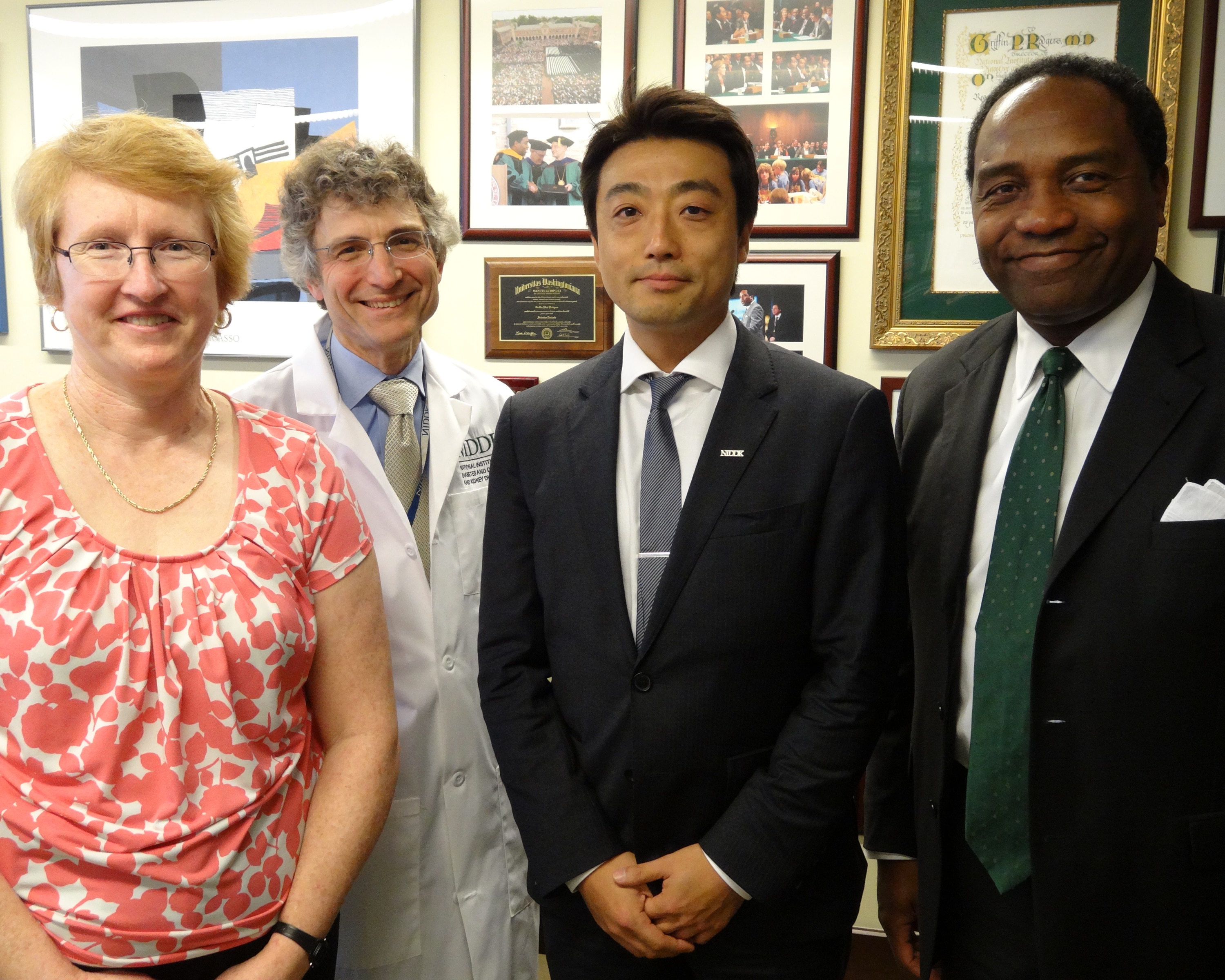
On April 15, NIDDK welcomed its newest recipient of the Presidential Early Career Award for Scientists and Engineers (PECASE), Dr. Shingo Kajimura of the University of California, San Francisco. “Dr. Kajimura is an exemplary young investigator and a swiftly rising star in the field of cellular metabolism,” said NIDDK Director Dr. Griffin P. Rodgers of the NIDDK grantee. “His work in adipocyte biology and obesity are already frequently cited, and his ongoing research advancing understanding of the regulatory circuits that control fat cell fate, energy metabolism, and the development of obesity hold the promise of significant contribution to his field and to public health.” Here, from left, Dr. Carol Haft, NIDDK program director for adipocyte biology; NIDDK Deputy Director Dr. Gregory Germino; Kajimura and Rodgers meet on the NIH campus during Kajimura’s trip to Washington, D.C., to accept his award from the White House.
